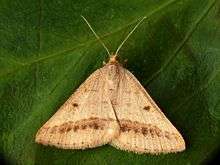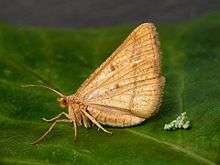Isturgia arenacearia
Isturgia arenacearia, the sand bordered bloom, is a moth of the family Geometridae. It was first described by Michael Denis and Ignaz Schiffermüller in 1775.
| Isturgia arenacearia | |
|---|---|
 | |
| Female | |
 | |
| Female with eggs | |
| Scientific classification | |
| Kingdom: | Animalia |
| Phylum: | Arthropoda |
| Class: | Insecta |
| Order: | Lepidoptera |
| Family: | Geometridae |
| Genus: | Isturgia |
| Species: | I. arenacearia |
| Binomial name | |
| Isturgia arenacearia (Denis & Schiffermüller, 1775) | |
| Synonyms | |
| |
Distribution
This species can be found in most of Europe (Sardinia, Corsica, Italy, Switzerland, Slovenia, Austria the Czech Republic, Poland, Slovakia, Hungary, Romania, Serbia and Montenegro, Bulgaria, Albania, North Macedonia, Greece, Crete, Ukraine and Russia) in the East Palearctic ecozone, and in the Near East.[1]
Habitat
These moths inhabit scrubs, dry steppes, xerothermic slopes, meadows and in areas cultivated with alfalfa.[2][3]
Description
Isturgia arenacearia has a wingspan of 21–27 mm. The basic color of the wings is light brown. The forewings have, in the submarginal area, a darker brown band. A barely visible line is also present, usually with a small dark spot. A series of small dark spots are present along the edge. The hindwings are cream-colored, crossed by a brown line and with small dark spots on the border. All four wings are fringed. The underside of the wings is predominantly gray or light brown. The thorax shows the same color of the wings, while the abdomen and the head are yellow ocher.[3]
Caterpillars are green with thin longitudinal white lines.[4]
This species is rather similar to Isturgia murinaria.
Biology
Adults fly in two generations from June to September.[2] The larvae feed on Coronilla varia, clover (Trifolium species) and various other Fabaceae.[3][5][6]
References
- Fauna Europaea
- Heiner Ziegler Schmetterlinge der Schweiz
- G. Doremi Altervista
- Kimmo Silvonen Larvae of North-European Lepidoptera
- Paolo Mazzei, Daniel Morel, Raniero Panfili Moths and Butterflies of Europe and North Africa
- Daniela Atanasova, Teodora Toshova, M. Subchev Seasonal monitoring of the yellow alfalfa geometrid, Isturgia arenacearia (Denis and Schiffermuller, 1775) (Lepidoptera: Geometridae) by pheromone traps in three regions of Bulgaria
External links
| Wikimedia Commons has media related to Isturgia arenacearia. |
- Savela, Markku. "Isturgia arenacearia (Denis & Schiffermüller, 1775)". Lepidoptera and Some Other Life Forms. Retrieved March 29, 2019.
- "07571 Isturgia arenacearia ([Denis & Schiffermüller], 1775) - Gelblicher Luzernespanner". Lepiforum e.V. Retrieved March 29, 2019.